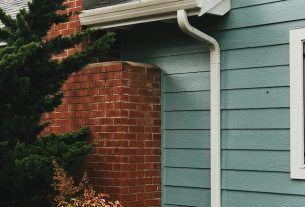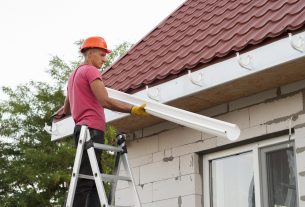Autumn is the time that depicts the most soul-captivating painting with falling leaves. Many-colored falling leaves do look beautiful, but can you imagine the potential harm that these same leaves, along with twigs, can cause to your gutters. And, the more you procrastinate gutter cleaning, the more chances of getting a clogged downspout on your hands.
So, here’s one effective method how to unblock a gutter downspout.
Debris Scooping or Spraying
Use A Ladder At A 45-degree Angle

Make use of an extension ladder tall enough to reach the top of your gutters. For every 4 feet of vertical height, move the bottom 1-2 feet away from your house. Lean the ladder against your house and ascend using three points of contact, such as two hands and one foot.
Additional Tips:
- If you need to climb 16 feet (490 cm), for example, set the ladder 4 feet (120 cm) away from the structure.
- Climbing on your roof to reach your gutters is dangerous since you are more likely to slip and fall.
- Stopping on the top rung of a ladder is never a good idea since you might quickly lose your equilibrium.
Remove Any Leaves That Have Accumulated Around The Downspout’s Top Entrance
Wear work gloves when cleaning to avoid being scratched on the gutters. Remove any debris from the downspout, which is the vertical portion of gutter that runs down the side of your house.
Put the debris in a bucket that is either hanging from your ladder or lying on the ground. If there are any leaves trapped in the downspout hole, pull them out.
If you need to bend over to reach the downspout, move the ladder closer to it.
Some downspouts may have a screen that covers the hole that can become clogged. Scrape off as much of the garbage as you can off the screen.
Tap A Stick Along The Length Of The Downspout To Check If The Clog Slides Out

To strike the downspout, use a scrap piece of plywood or a tool handle.
Begin on the ground at the bottom of the spout and tap firmly on the pipe’s external sides and front. Work your way up the downspout to see if any debris has fallen out.
Concentrate on mounting brackets because they frequently include screws that debris can get snagged on.
You may have located the clog if you heard a solid sound rather than a hollow ringing noise after striking the downspout. Try repeatedly touching that spot to see if the obstruction comes away.
Attach A Leaf Blower To The Downspout’s Bottom To Blast Out Dried Debris
If you have one, attach the gutter attachment at the end of the leaf blower.
Turn on the leaf blower and place it securely into the downspout’s bottom opening. Allow the leaf blower to run for 1–2 minutes at a time, and keep an eye on the gutters above you to see if any material falls out. If it doesn’t, try again in 1–2 minutes.
If you don’t have a gutter attachment for your leaf blower, place the end of the blower against the downspout’s bottom. To make a tight seal, wrap a towel around the connection and push it into the gutter.
Important tips to keep:
- Wet material is heavier and more difficult to pull out with a leaf blower.
- Avoid utilizing a leaf blower from the top hole of the downspout since you’re more likely to fall off a ladder.
To Assist Rinse Away The Blockage, Squirt Water From A Hose Up The Downspout

Use a high-pressure hose to help you break the blockage apart.
Feed the hose end into the bottom of the downspout until you can’t go any farther. Turn on the hose and move it around to assist in dislodging the clog.
Push and pull the hose every now and then to see if you can get it any higher. When you’re through cleaning it, remove the hose.
Little Tip: If your water pressure is poor, the hose may not be able to clear the blockage.



